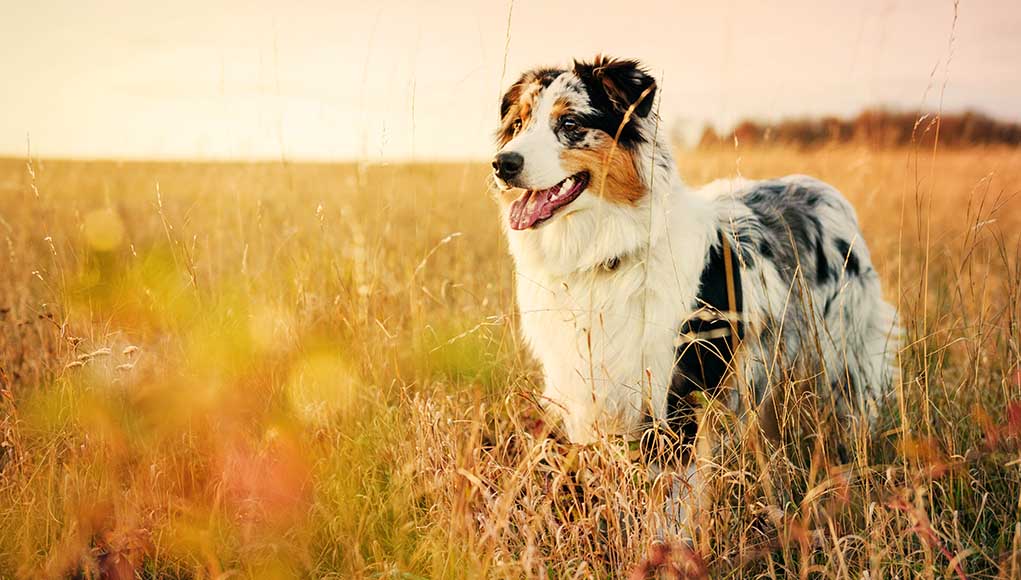Table of Contents
- History of the Australian Shepherd
- Australian Shepherd Breed Standard
- Fun Facts About Australian Shepherds
- Characteristics of an Australian Shepherd
- Australian Shepherd Temperament & Personality
- Care & Grooming for Australian Shepherds
- Nutrition and Feeding of an Average Australian Shepherd
- Health and Common Illnesses of an Australian Shepherd
- Frequently Asked Questions about the Australian Shepherd
- Final Thoughts About the Australian Shepherd
The Australian Shepherd is a lovable breed that would always turn heads when they are out for a walk. Their strong stance and flowing hair create an elegant touch to their overall look.
Aussies, as they are affectionately called, are intelligent and friendly dogs that you can rely on as a loyal canine companion to you and your family.
This breed profile shares all there is to know about this playful breed and how you can take better care of them. Not to mention, we’ll be debunking one common myth about Aussies.
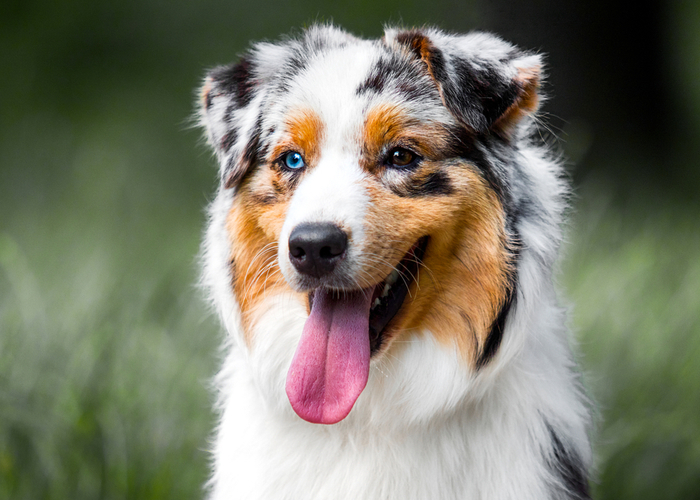
History of the Australian Shepherd
Let’s set one thing straight first: Australian Shepherds are not really from Australia. In fact, they are from the mountains of Europe.
It was in the borderline between Spain and France, near the Pyrenees Mountains, that you can find an indigenous tribe called the Basques.
They were the world’s greatest shepherds and maintained that centuries-old reputation. With them is a herding dog called the Pyrenean Shepherd, an ancestor of the Australian Shepherd.
During the early 1800s, the Basques were in search of rich pasture land until they sailed and found themselves in the seemingly untouched continent of Australia.
In their long journey in Australia, they have refined the breed by crossing them with the country’s British imports, Border Collie and Collie.
The Basques then set out to California in search of a greener pasture (literally) for better cattle ranching. From there, the breed received much attention.
California ranchers were in awe of the Basque’s herding breed. They even thought it was from Australia — thus, the name and the confusion.
The cowboy culture in the American West quickly adopted the Australian Shepherd, and this started the breed’s notably strong associations with cowboys and rodeos.
Today, you will still see Australian Shepherds in farms and ranches as they continue to protect sheep and herd cattle.
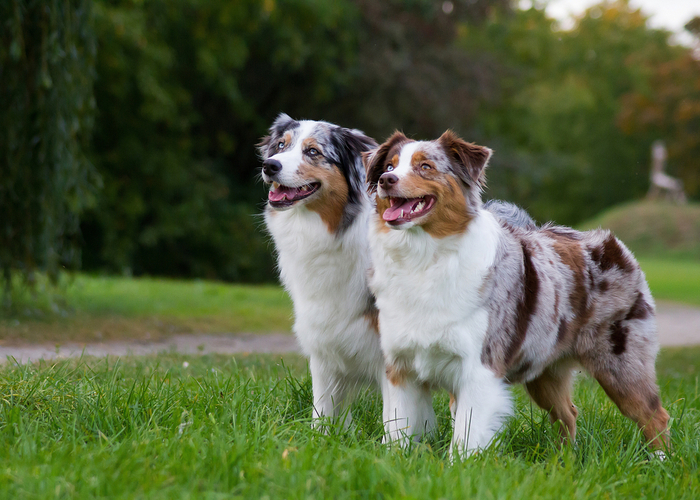
Australian Shepherd Breed Standard
The Australian Shepherd was recognized as a breed and listed in the American Kennel Club in 1991. A year before that, the United States Australian Shepherd Association was formed.
In 1993, the breed got into the AKC Herding Group. For several years, the Australian Shepherd has ranked 15th in the AKC Breed Popularity Ranking.
As of 2020, the Australian Shepherd became the 12th most popular breed according to the American Kennel Club.
Fun Facts About Australian Shepherds
The Australian Shepherd is a unique breed that has facts and attributes that most people didn’t know. For instance, there is a story behind their name, its misconception, and many more:
- Australian Shepherds are not exactly from Australia. In fact, they originated from Europe with the shepherds called the Basques.
- Aussies have never been listed in Australia as a native breed. It was registered only until the 1950s.
- This breed has a very keen sense of smell that they are often partnered with the police to sniff out narcotics.
- Because of their strong association with cowboys and the Western culture, they’ve taken the spotlight and become popular in Hollywood movies like Run, Appaloosa, Run and Stub, The Best Cowdog in the West.
- Despite their energetic and territorial nature, Australian Shepherds are actually a softie. They are velcro dogs who are clingy to their owners and would love to be beside them all the time.
- This beautiful pooch has amazing two-colored, even marbled, eyes! It’s not uncommon for an Australian Shepherd to have eyes of different colors.
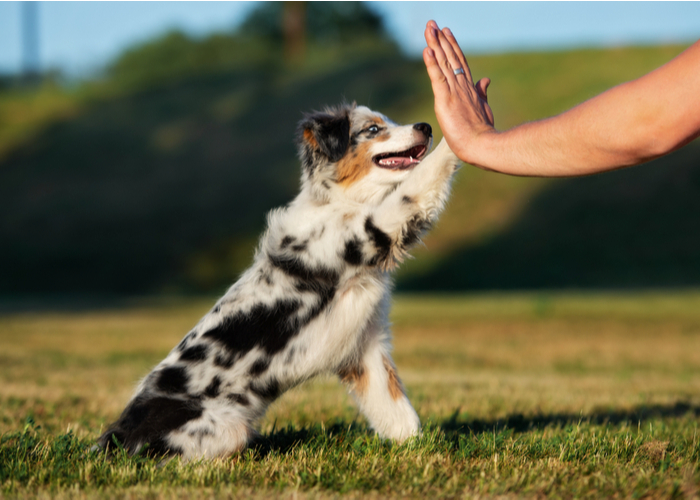
Characteristics of an Australian Shepherd
There are several categories according to the breed standard by the AKC. They also have different looks which shouldn’t confuse you because they are the same breed, after all.
Appearance
The Australian Shepherd is a ranch dog with a lean and tough body structure. Belonging to the herding group, they are medium-sized dogs of a solid build.
Aussies have two layers of coat: the topcoat is made of wavy hair in medium length. The undercoat helps them regulate body temperature during both warm and cold climates.
Their tails are naturally short, but there are people who actually dock the Aussie’s tails. The American Veterinary Medical Association discourages tail docking for its health risks.
Red or red merle Australian Shepherds tend to have red-eye rims, lips, and noses while blue or black ones have black-colored eye rims, lips, and noses.
The Aussie’s eyes are quite catchy as they can have two different colors or patterns in each eye. The range of eye colors includes amber, blue, brown, blue marbled, or any pattern in between.
Size of the Australian Shepherd
The male Australian Shepherd stands from 20 to 23 inches, weighing 50 to 65 pounds. As for the female Aussies, they stand from 18 to 21 inches that weigh 40 to 55 pounds.
Coat Type, Color, and Markings
Australian Shepherd has double coats with hair of medium length. They require frequent brushing, but there is no need to take a full bath every week.
There are four breed colors listed in the breed standard by the AKC. They are as follow:
- Black
- Blue Merle
- Red
- Red Merle
The Australian Shepherd also has three listed markings, which contributes to their distinct look:
- White Markings
- Tan Points
- White Markings, Tan Points
Australian Shepherd Temperament & Personality
The Australian Shepherd has strong herding instincts and is a furball packed with energy! They’d love to play with you, hike, or go out on a run.
This energetic breed would prefer engaging in physical activities and sports. They would do great in dog shows and obedience competitions.
Because of their undercoat, they are tolerant of both warm and cold climates. This shouldn't stop you from owning an Aussie, wherever you are in the world.
Aussies are fast learners and easy to train. They are even trained like police dogs for search and rescue, guide or service roles, and narcotic detection.
You may find this territorial pooch chasing around prey. However, when it comes to strangers, they are shy and would quickly go beside their owners.
They are not aggressive but lovable creatures who only want your time and attention. Aussies could only become destructive if they are left alone at home for too long.
Having a bad case of separation anxiety, the Australian Shepherd would love to go anywhere you go, whether it’s on an errand or in the bathroom.
Family Dogs
Australian Shepherds are excellent family dogs. Their herding instincts tend to kick in when it comes to handling your children.
Keep in mind that this breed can get too playful and has the tendency to nip at the ankles of your children and other family members.
Having your Aussie trained beforehand and supervising their interactions are the best ways to protect both your pooch and child.
ALSO READ: 35 Best Medium and Small Dogs for Kids
Care & Grooming for Australian Shepherds
Australian Shepherds have medium-length hair, and they are seasonal shedders. They need regular brushing with a de-shedding brush to manage excessive hair fall.
These Aussies experience heavy hair shedding during spring and fall. During this time, vets recommend brushing their fur at least twice a week.
If you are planning to have your Australian Shepherd shaved, most vets strongly discourage any owner from doing so. Their coat may not grow back to how it was before.
When you shave your Aussie’s hair, they would have difficulty regulating their temperature.
You can ask your groomer to trim their hair short without completely shaving them off.
Just like any dog breed, their nails should be trimmed monthly. You also need to check and clean their ears from any obstruction.
Mental Health in Australian Shepherds
Believe it or not, dogs have mental needs too! They’d get sad or frustrated when these needs are not met.
The Australian Shepherd has a more demanding need for mental stimulation. They need daily interactions and challenging, playful activities.
The lack of mental stimulation will get your Australian Shepherd to act out. They would start to get bored and ruin some of your furniture at home.
Nutrition and Feeding of an Average Australian Shepherd
This canine is a medium-sized breed with a high energy level. With this said, they need just enough food to keep them healthy and happy.
There is plenty of quality dog food that is suitable for your pooch from its puppyhood to the adult stage. You can choose a commercial brand or make homemade dog food yourself!
Check your dog’s weight and calorie consumption regularly to avoid obesity. Provide fresh and clean water to your Aussie at all times.
Health and Common Illnesses of an Australian Shepherd
The Australian Shepherd is a healthy breed in general. They can live up to 12 to 15 years, so you can hang around with your pooch for a very long time.
On the other hand, hereditary health problems may be inevitable for this breed. Aussies are genetically prone to bone, hearing, and eye ailments.
An Australian Shepherd could easily acquire hip and elbow dysplasia, cataract, and epilepsy through their genes. In the worst cases, they could have hereditary cancer like lymphoma.
Fortunately, you can have the breeder test your pup for eye problems, drug sensitivities, and autoimmune thyroiditis. Here are the recommended tests:
- Canine Ophthalmologist Evaluation
- Elbow Evaluation
- Hip Evaluation
Double merle Australian Shepherds with a dominant white color are prone to sight and hearing diseases. However, this is only rare and not always the case for Aussies with this coat type.
Breeding is not encouraged to Australian Shepherds with any of the genetic issues. Also, if you are adopting an Aussie, ask a reputable breeder first and check the pedigree history.
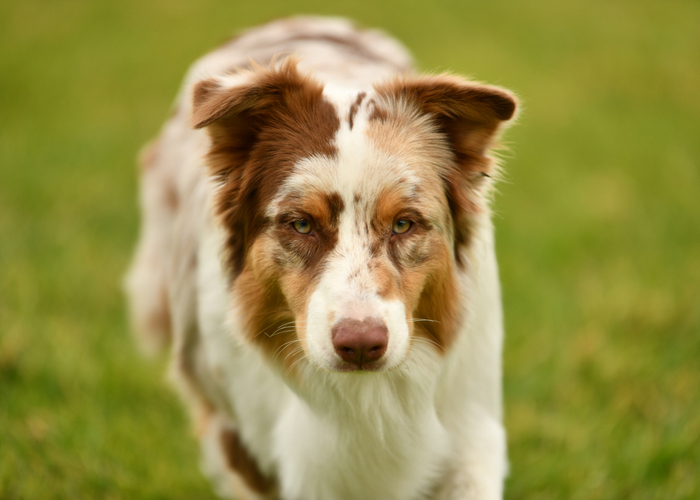
Frequently Asked Questions about the Australian Shepherd
Got questions? Well, you are not alone. Here are the common questions that most people ask about the Australian Shepherd:
Is an Australian Shepherd a good family dog?
Being an energetic, sweet, velcro dog, the Australian Shepherd loves to spend time with your family and kids. Aside from playing around, they would love to snuggle in bed or couch.
Their herding instinct applies not only to cattle and sheep but also to little children. You can rely on them to keep a sharp eye on your kids.
What is bad about the Australian Shepherd?
The Australian Shepherd is a generally versatile breed for any living environment. They are known for their intellect, high energy level, and trainability.
On the other hand, Australian Shepherds may be more prone to genetic diseases compared to other breeds. Aussies with white coats tend to have inherited sight and hearing impairments.
Other genetic illnesses that often occur to an Australian Shepherd are hip dysplasia, lymphoma, epilepsy, cataracts, and many more.
Does an Australian Shepherd shed a lot?
They are seasonal shedders and often experience serious shedding during fall and spring. They need frequent brushing to keep their coat silky and smooth.
There are different types of dog brushes you can use to minimize shedding and matting in your Aussie’s fur. You can also have it trimmed by a groomer for a cleaner look.
Do Aussies bark a lot?
The usual Australian Shepherd is not exactly the quietest breed there is. They tend to bark a lot when they want attention or need to alert you.
The best thing about Australian Shepherds is that they are very easy to train. You can even use their barking skills to your benefit.
You can start training them for commands like “Speak.” In police work or guarding, they can be trained to bark the instant they see any threats to alert you.
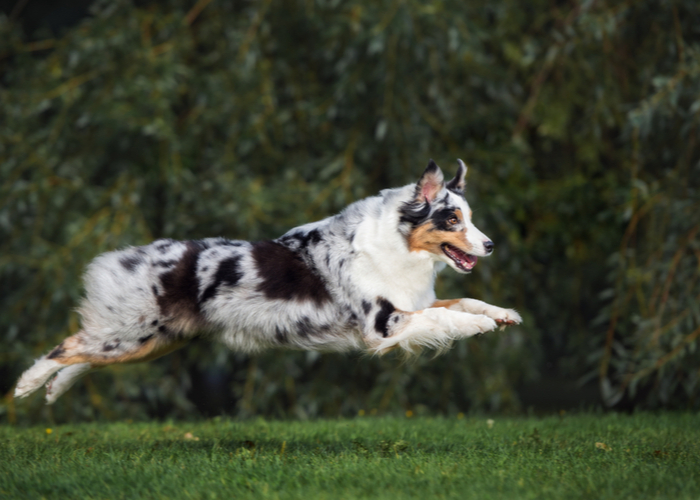
Final Thoughts About the Australian Shepherd
If you are planning to adopt an Australian Shepherd, then this breed profile is just the guide you need!
The Australian Shepherd is a likable breed that requires only minimal maintenance. They get along with family members and children alike.
Just like any dog breed, they would require your time and attention. They are livelier than most breeds so it’s best that you have an active lifestyle as well.
You may ask the breeder about the health tests given to the Aussie pup beforehand. Fortunately, there are many respectable dog breeders whom you can rely on when adopting a pooch.
If you are still hesitant, you can ask the breeder or local vet for expert advice and a more in-depth assessment of the right breed for you.
READ NEXT: Best Dog Food for Australian Shepherds: 7 Vet Recommended Brands


